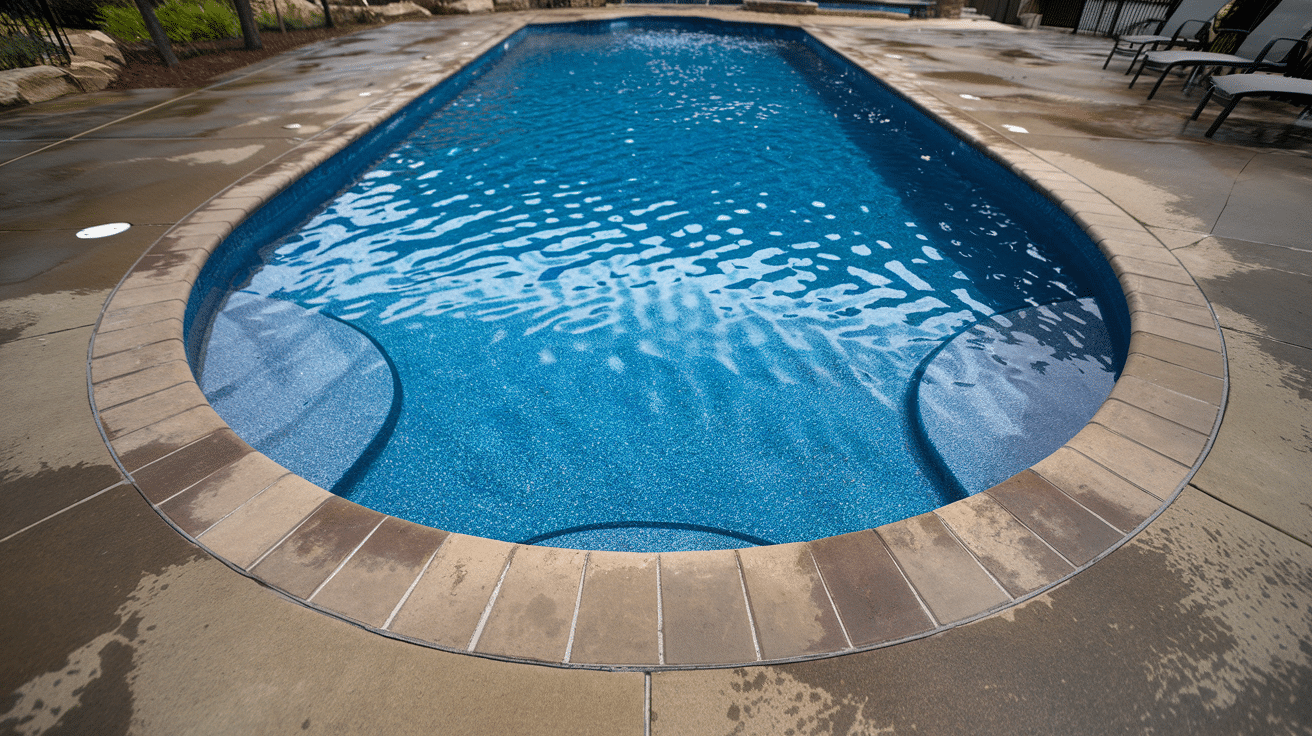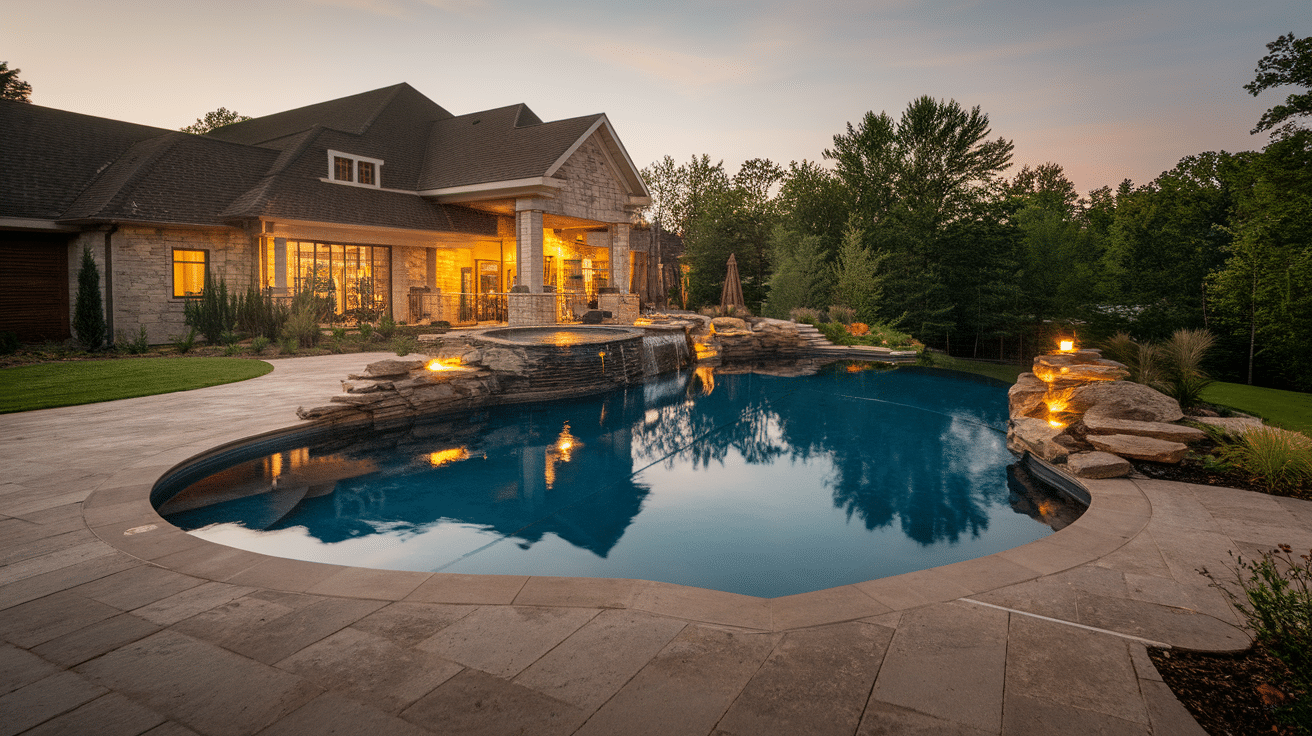Dreaming of a stunning pool that blends seamlessly with your outdoor space? The secret might be right at the edge!
Poured concrete coping creates that flawless transition between water and land that upgrades your entire backyard oasis.
Unlike pre-made options, this method delivers a custom-fit border that looks like it was born with your pool.
From modern straight lines to gently curved edges, the possibilities are endless. The best part? This option delivers designer looks without the designer price tag.
Whether you’re building a new pool or refreshing your current one, learn why savvy homeowners are choosing this durable, versatile solution for their pool edges.
What is Poured Concrete Coping?
Poured concrete coping is a method where liquid concrete is poured into forms placed around the pool edge. These forms shape the concrete as it dries.
Once hard, the forms are removed to reveal the final coping. This creates a solid, one-piece border that fits perfectly with your pool design.
Unlike pre-made coping pieces, poured concrete joins directly with your pool deck for better strength.
While still wet, the concrete can be mixed with colors or stamped with patterns. This gives pool owners many style options without extra costs. The result is a clean, smooth edge that looks like it was made just for their pool.
Poured Concrete Pool Coping Benefits
- Durability: Stands up to weather, heavy use, and pool chemicals for many years.
- Cost-effectiveness: Usually costs less than stone or pre-made options, especially for larger pools.
- Versatility in style: This can be shaped, colored, and textured in many ways to match your yard.
- Seamless integration: This creates a smooth flow between your pool and deck with no gaps.
- Custom-fit: Works with any pool shape, even unusual designs that pre-made pieces can’t fit.
Types of Poured Concrete Coping
1. Cantilever Coping
This style hangs over the pool edge, giving it a floating look. The concrete extends past the pool wall by 1-2 inches, creating a small lip. This design works well for modern pools with clean lines.
Water flows off the coping edge neatly, adding a nice visual touch when the pool is in use.
2. Modern Coping
Modern copying features straight, sharp lines that create a neat finish. This style uses square edges instead of curved ones. It suits homes with a simple, clean design style.
The flat, straight surfaces highlight the water and make the pool look structured and planned.
3. Bullnose Coping
This type has a rounded front edge that feels smooth to the touch. The curved shape makes it safe and comfy for swimmers to hold onto.
Families with children often choose this option since it reduces the risk of scrapes or bumps. The gentle curve also gives the pool area a softer, more classic look.
4. Exposed Aggregate Coping
This finish shows small stones in the concrete by washing away the top layer of cement. The result is a textured surface that prevents slips and adds visual interest.
Each mix creates a unique pattern based on the stones used. This type works well in areas that get wet often and need extra traction.
5. Stamped and Decorative Coping
Custom patterns can be pressed into fresh concrete using special forms. This method lets you copy the look of brick, stone, or tile without their higher cost.
You can choose from many patterns and add colors to match your yard or home. This approach offers a good mix of looks and value.
Foam Forms for Poured Concrete Coping
Foam forms are molds used to shape poured concrete as it hardens. They create the exact profile and edge style for the coping, ensuring clean edges and fewer fixes later.
Once removed, foam forms come in various shapes to offer different looks for the coping.
Comparison of Popular Brands
| Brand | Features | Pros | Cons |
|---|---|---|---|
| Stegmeier Foam Forms | Commonly used, known for its durability and reliability. | Widely used, and installers are familiar with it. | Requires double-sided tape or tie wires. |
| Modern Molding Foam Forms | Uses reusable clips for quicker setup and accuracy. | Faster setup, reusable clips, more precise. | It may cost more than traditional forms. |
Key Considerations When Choosing Foam Forms
-
Size Availability:
Foam forms come in common lengths, such as 4-foot, 8-foot, and 12-foot sections. -
Ease of Installation:
Some systems require less skill to set up correctly. -
Cost Implications:
USA-made forms may be more expensive but often arrive faster and in better condition.
Ideas for Customizing Your Pool Edge
1. Mixed Materials
Combine poured concrete with sections of stone, brick, or tile. This method creates visual interest and highlights special areas around your pool.
You might use a fancier material at entry points while keeping the rest simple. This approach lets you add high-end touches without the full cost.
2. Color and Pigmentation
Add color to your concrete mix or apply stains after it dries. Match colors to your home, yard features, or personal taste. Lighter colors stay cooler in the sun, while darker ones add contrast.
Some people use multiple colors to create patterns or mark different pool areas.
3. Integrated Lighting
Place small lights under cantilever edges or within the coping itself. Lights improve safety at night and create a nice mood for evening swims.
LED options use little power and last for years without much care. This feature turns your pool into a focal point after dark.
4. Incorporating Greenery
Create small spaces within or near the coping for plants. Small pockets can hold low-growing plants that soften the pool’s edge. Choose pool-friendly plants that don’t drop leaves or need much water.
This touch brings life to the hard surfaces around your pool.
5. Unique Form Designs
Use custom-shaped forms to create special edge profiles. Go beyond basic shapes to make your pool truly one of a kind. This might include waves, steps, or other shapes that match your home style.
The only limit is what can be created with the forming method you use.
Installation Process for Poured Concrete Coping
First, measure your pool edge carefully to determine how many forms you’ll need. Then, clean the bond beam (the top of the pool wall) thoroughly to help the concrete stick.
Attach the forms using the method appropriate for your chosen brand. Check that all forms are level and at the same height.
Mix concrete to the proper strength, often 4000 PSI or higher, for pool use. Pour carefully to avoid moving the forms out of place. Smooth the top surface and create any texture you want while the concrete is still wet.
Wait the full cure time before removing forms, usually 24-48 hours, depending on the weather.
After removing the forms, check the edges for rough spots and smooth them if needed. Allow the concrete to cure fully (about 28 days) before heavy use or sealing.
Cost Considerations
Key Factors Affecting Price
- Pool size and shape- More complex shapes require more labor.
- Edge style- Some edges need more skilled work.
Material Costs
- Concrete is usually less expensive than stone options.
- Form costs can vary, with some brands being much more expensive.
Average Costs
- Homeowners typically spend $30 to $60 per linear foot, including materials and labor.
- This makes it a mid-range option in the pool-coping market.
Maintenance and Durability
With proper care, poured concrete coping can last 20+ years. Clean it regularly with plain water or mild soap to remove dirt and prevent stains. Apply a good sealer every 2-3 years to protect from water, UV rays, and pool chemicals.
Check for cracks each spring and fix small ones before they grow. A concrete crack sealer can fill small cracks. Keep heavy items away from the coping edge to prevent chips or breaks.
If the coping starts to look dull, you can refresh it with a new coat of stain or sealer. Unlike some options, concrete can usually be renewed without total replacement.
Conclusion
Poured concrete coping offers pool owners a good mix of style, cost, and lasting quality. The concrete can be molded into many shapes and colors to fit your yard’s look.
It creates a smooth line between your pool and deck that looks clean and planned.
When choosing your pool edge, think about how you use your pool and what style suits your home. Good coping adds both safety and appeal to your swimming area for many years.
Are you not sure what to pick? Talk to a pool builder and look at different options in person. Find what fits your needs and budget.
Ready for a new pool edge? Get quotes from several good contractors. Look at their past work to find the best team for your project.















